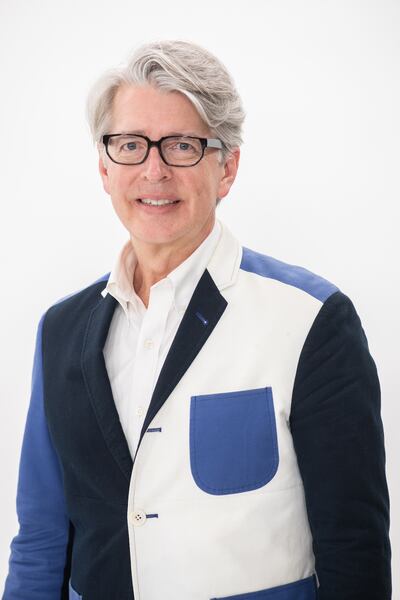
The Supima Design Competition (SDC) celebrated its 17th year this month, returning to the Prince George Ballroom for a runway presentation at New York Fashion Week, presenting collections designed by this year’s finalists.
The SDC focuses on bridging the transition between academic experience and launching a career in fashion by working with BFA graduates from six partner design schools from across the US. This year’s winner was Emma Joan Foley, from Parsons School of Design, The New School.
The school-selected finalists were challenged to design a women’s eveningwear collection made exclusively from five Supima cotton fabrics provided by the non-profit trade association: denim, twill, corduroy, knit and velveteen, with one look constructed from each material.
In addition to the SDC, Supima donates yardage to partner schools’ fashion departments and teaches classes about Supima’s quality and responsible production practices, helping students to understand raw materials like cotton, the different ranges of quality and how that can impact final designs.
The SDC offers a structured programme for the finalists, with weekly deliverables and check-ins to review progress by an in-house team of mentors lead by Bibhu Mohapatra, who celebrated his 10th anniversary as mentor to the competition this year. Partner schools also provide a mentor and allow their Bachelor of Fine Arts (BFA) graduates to continue to use school facilities.
“Every year we feel like we have seen everything under the sun when it comes to manipulation of the fabrics, creativity and uniqueness in design and silhouettes. But the new group comes in and they continue to impress, pushing Supima to new levels,” shared Buxton Midyette, VP of marketing and promotions at Supima.
This support is intended to give finalists the experience of running their own atelier. Indeed, alumni such as Andrew Kwon, Alexandra Pijut and Jeffrey Taylor have all launched namesake labels since participating in the SDC.
“They come away with an impactful portfolio that puts them head and shoulders above the crowd and allows them to pursue their dreams — whether that’s additional education at the MFA level, starting their own brand or working for a top fashion house — they can chart their own course,” added Midyette.
This year’s host was designer Phillip Lim, who joined a panel of established industry professionals including the likes of fashion creatives Jerome Lamaar and Cipriana Quann, founder of New York Fashion Week Fern Mallis and fashion writers Godfrey Deeny, Lisa Lockwood and Mickey Boardman in judging the collections.
“We like to get a really diverse group ranging from stylists to designers to press to influencers and even former finalists themselves — a real range of experiences,” said Midyette. “Many have been judging the competition for multiple years and are extremely helpful in terms of networking, often assisting with placements for the designers and are very active in terms of matching finalists with opportunities.”
[The finalists] come away with an impactful portfolio that puts them head and shoulders above the crowd and allows them to pursue their dreams.
Founded in 1954, Supima is the non-profit marketing and promotional brand for Pima cotton grown exclusively in America. The rare fibre is grown by just over 300 family farms and represents the top 1 percent in cotton quality, since its longer fibre contributes to a stronger final product, with lasting colour and thereby longer wear.
“We’re excited to have launched the full transparency and traceability authentication of Supima last year through our AQRe Project. You can now trace that t-shirt on the retail shelf all the way back to the cotton. So to the fabric, to the spinning of the yarn, all the way back to the ground where it was grown,” added Midyette.
BoF spoke to the six finalists from this year’s competition to learn more about their experience of Supima’s mentorship and learnings from working with the five Supima fabrics.
Emma Joan Foley
Emma Joan Foley studied fashion design in the collection pathway at the Parsons School of Design. During her studies, she developed skills in dressmaking and tailoring, creating contrasting pieces which involve draped technical elements and flat pattern work. She also specialised in leather.
“I wanted to use cotton-based materials in my personal thesis studying at Parsons, but it ended up being out of budget. Some of the fabrics that we work with in this collection are not textiles I would normally pull, so it has been exciting for me to develop a cohesive collection with complementary manipulations across the five looks. I manipulated all five fabric types with coating variations to mimic leather, paired with panelling and etching motifs. In this project, I have really been able to explore melding my leatherworking skills into fabrics, both in manipulation and construction.
“I am so looking forward to — and already enjoy experiencing — receiving feedback and learning from design and industry professionals outside of Parsons, across different facets of the fashion industry. I feel lucky to have the space and materials to expand my work, my process and my knowledge throughout this competition.”
Mina Piao
Mina Piao studied fashion design at The Fashion Institute of Technology (FIT) in New York, where she specialised in knitwear. She is particularly interested in the sustainable capabilities of knitwear, as well as biodegradable materials.
“There are very few platforms that provide this level of exposure and support for recent fashion graduates. This is my first experience managing a team as a designer — it’s been critical for my development. The Supima team organised a cocktail reception after the first model fittings, where I had the opportunity to meet everyone in person. The FIT finalists from the past two years, Bryan Barrientos and Heejin Hwang, have been incredibly supportive and helpful in navigating this competition.
“Supima is offering yarn for the first time this year, which has been amazing to work with. The Supima yarn has a smoother hand and better drape than other unmercerized cotton yarns I’ve worked with before. I didn’t think it would be possible to pleat 100 percent cotton, but the Supima shirting fabric holds pleats surprisingly well. I am soaking the denim fabric with an algae-based bioplastic to create different designs, including fabric ‘sequins’ made from fabric offcuts.”
Marina Lamphier
Marina Lamphier studied fashion design at Drexel University in Philadelphia, with a focus on performance-wear wovens. Lamphier is particularly passionate about design innovation and how it can be used functionally to resolve everyday problems.
“Being surrounded by such a talented and driven group of designers is so inspiring. It’s like the saying goes: if you’re in a room with six millionaires, you’ll become the seventh. When you’re in the presence of such ambitious, accomplished creatives, you inevitably absorb their similar energy and mindset.
“One of the most important lessons I’ve learned in my design journey is the value of cooperation with your resources. It is crucial to plan according to the time available, design to highlight your strongest skills and tailor your designs to the unique qualities of each fabric. In this collection, I’ve embraced the opportunity to highlight the contrast between softness and strength and to balance structure with flow, celebrating the unique attributes of each fabric.”

Lizzy Truitt
Lizzy Truitt is a recent graduate from Kent State University in Ohio, where she achieved a Bachelors in fine arts for fashion design, specialising in womenswear and a keen interest in concepts and surface design. Having grown up on a family farm producing short staple cotton, sustainable fabrics is an important topic in her work.
“Being able to display Supima fabrics while debuting a collection during New York Fashion week is the best of both worlds. My collection reflects how my upbringing and family continuously influence and inspire me as a designer. Having firsthand knowledge of the importance of family-owned farms, the fashion industry can not only improve its impact on the environment but make a direct impact on uplifting and including local communities as we innovate into the future.
“One of the main techniques used within my collection is inspired by quilting in modern ways. With Supima cotton, it has an incredibly soft hand. And because of its unique extra-long staple, it is more durable and provides much less pilling when it comes to doing reverse applique.”
Jules Gourley
Jules Gourley is a graduate of the School of the Art Institute of Chicago, where they studied fashion design, developing core skills in pattern drafting, tailoring and working with leather. They also spent time developing skills in footwear design and bespoke footwear as part of their studies.
“I work in a material-first capacity, so this has pushed me into certain design decisions based on that. I don’t think I ever finalise a look until I have the final fabric in hand. My goal is to create garments that best utilise the properties of each Supima cotton fabric.
“I think if there’s a silver lining to how much social media permeates fashion culture, it’s how it can help smaller designers find an audience. I think doing small made-to-order garments is my ideal vision for being sustainable with fashion. Personally, I feel that there is something undesirable about doing large productions of clothes that don’t have a designated home. I’m also very excited about how many fabric mills and tanneries are committing to more ethical practices for production as well.”
Henry Hawk
Henry Hawk studied apparel design at the Rhode Island School of Design (RISD), specialising in denim, menswear and tailoring. He is fascinated by the history of denim and workwear and how denim’s traditional usage in jeans can influence a sustainable future of denim production.
“I’m so thankful for the opportunity to make another collection fresh out of college. I think that alone is amazing and not something most grads get to do right away. Not to mention with amazing fabrics and sharing it on the biggest stage I’ve ever had a chance to. A teacher, before I started, told me it’s like a summer grad school, but free. I’ve learned so much and pushed myself out of my comfort zone for this collection. It’s a special thing to be a part of.
“I think a lot of innovations for fabric, or sustainable methods, can be learnt from the past. Natural fibres, natural dyes, no added stretch, removable buttons so clothing is fully recyclable — I hope we can start to make stronger circular systems that don’t cut any corners from the start to the end of the life cycle of a garment.”
This is a sponsored feature paid for by Supima as part of a BoF partnership.



